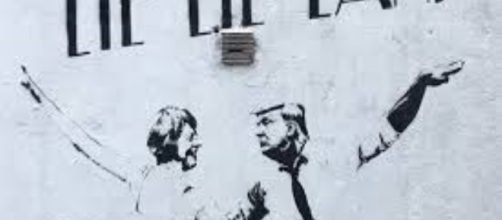An old Chinese proverb attributed to Confucius has it that a picture is worth a thousand words. Napoleon had his own version: A good sketch is better than a long speech. Both sayings set the scene for today’s column about street art spray-painted on a wall in north London. The image is by the political graffiti artist known as Bambi, who used the movie poster image of Ryan Gosling and Emma Stone dancing in the popular musical “La-La Land” to make a point about Trump’s problems with telling the truth. She calls her painting “Lie-Lie Land.” What you see is the movie’s happy couple but with the faces of Trump and UK Prime Minister Theresa May, which has the effect of changing the mood of two people tripping the light fantastic to a pair cavorting oblivious to the troubled world around them.
Why is May in the picture? Despite a petition of 1.85 million Brits pleading with her to cancel a state visit from Trump, she’s chosen to welcome him.
Only in the movies
In a written statement explaining how she got the idea for “Lie-Lie land,” Bambi said she saw the movie poster throughout her city of Gosling and Stone in their care-free dance in stark contrast to the “dark political time in our world.” How powerful is Bambi’s image? Compare it to current art museum shows protesting Trump for his executive order to stop visits by people from seven Muslim countries. The Davis Museum at Wellesley College, Boston Massachusetts either has taken down or shrouded in black cloth 120 works - paintings, and sculptures - from Europe, Africa and the Americas from its permanent galleries in a kind of non-exhibit called the "Art-Less" project.
Such a show title may give the unfortunate impression that the works in question are not art. One example of art no longer on display is a picture of George Washington by 18th century Swedish painter Adolf Ulrik Wertmuller, which would normally have been part of celebrating President’s Day. Museum director Lisa Fischman told the Boston Globe that the missing works are identified with labels explaining that they’re either “made by an immigrant” or “given by an immigrant.” The problem with this idea is that in order to appreciate the museum’s effort, you need explanations.
With Street Art that turns a popular movie image into a spoof of heedless political leaders, you don’t need more.
Looking for a happy ending
The same thing can be said of the Museum of Modern Art’s effort to direct attention to immigrant art. In this case, MoMA switched out displays of Picasso and Matisse with artists from lands in Trump’s travel ban.
And again, there are explanatory statements on the exhibit walls, such as, “This work is by an artist from a nation whose citizens are being denied entry into the United States, according to a presidential executive order issued on January 27, 2017.” But is it a good idea to look at art according to an artist’s ethnicity?

